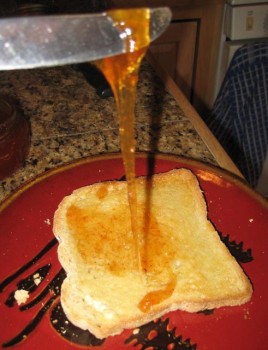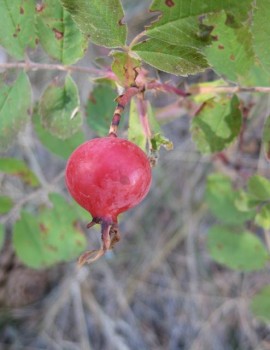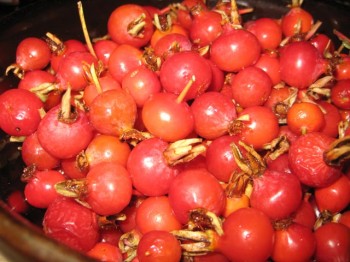
It was supposed to be wild rosehip jelly, but it came out more like candy spread. Dip a knife into it and the goo remains attached by a long, sticky strand, and when you serve yourself some “jelly” and then put it away and take it back out again, it’s all settled back down like no one had ever touched it. Oh well. It still tastes good. The funny thing is that this is the first time in my short jelly-making career that I tried to follow an official recipe—and look where it got me!
Rosehips are the “hips,” or swollen bases, of wild rose flowers (Rosa species), as explained by Connie and Arnold Krochmal in A Naturalist’s Guide to Cooking with Wild Plants (1974). They were used to make tarts, jellies, and jams by medieval Europeans.
I don’t recall the first time I heard that rosehips were well-suited for jelly-making, but the memory has been with me a long time. I remember looking longingly at the big, fat rosehips on the Rhode Island shore where I vacationed with my family as a child, but never being daring enough to taste them, let alone attempt to make jelly out of them.

We found our Colorado rosehips where a hillside of ponderosa pine forest meets a big, open meadow on the outskirts of Fort Collins after Gregg’s sister called us down for a sticky gumweed bounty that proved too good to be true. The gumweed was by then past its sticky prime, but we found wild plums (also past their prime, but good to know about) and a thicket of ripe, red rosehips that yielded two cups when foraged sustainably (ie taking some but leaving a bunch). These Colorado rosehips were nowhere near the size of the Rhode Island rosehips of my memory, but they were plump and bright rose-red, fully ripe and slightly soft to the touch.
The rosehip jelly recipe came from the Krochmal’s book, which was also the source of a very successful South Seas purslane and dandelion root salad I made earlier this year. Since all my other jellies to date have been bastardized from an Ehow raspberry jelly recipe, I figured an actual recipe for rosehip jelly was a safe bet.
Not so much. First, the water boiled down to nothing and I had to add more (Oh, sudden realization: I forgot to cover the pot as directed!) Still, the recipe called for a total of 55 minutes on the stove, which is a lot longer than I cooked my other, more successful jellies. And finally, the recipe didn’t call for pectin, presumably because pectin occurs naturally in rosehips? (Or else, maybe the authors forgot it, as a brief internet search revealed several rosehip jelly recipes requiring apples, which I know contain the requisite pectin.)

And so, what a funny gooey creation I ended up making! Not that it makes much difference after it’s spread on toast, although even that requires careful application so as not to gooify the entire kitchen. The taste is pleasantly sweet and subtle, somewhat reminiscent of soapberry jelly but without the weird bite at the end. The smell reminds Gregg of Pepperidge Farms turnovers he used to eat growing up.
If it’s not an already obvious cognitive leap, cultivated rosehips can be substituted for their wild relatives—provided, of course, that they have not been sprayed with chemicals. In addition to the jelly recipe, the Krochmals include recipes for zucchini with rose hip sauce, stewed rosehips, and rose hip syrup. Rosehips are high in Vitamin C, making them both a delicious and nutritious treat, like most wild edibles I know!

Leave a Reply